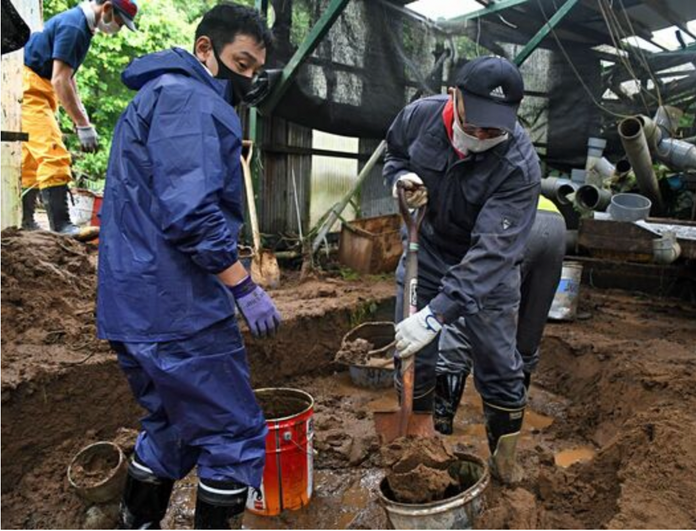Fish wiped out as river breaks its banks.
On Sunday as heavy rains continued to pound Aomori prefecture in the north of Japan, it was reported that one of the area’s fish farms had suffered catastrophic damage in the storms.
According to reports in the Asahi Shimbun, the country’s leading newspaper, the incident occurred when sediment-heavy water escaped from the Takahashi River and entered the Yamaguchi Fish Farm in Ohata, near Mutsu City, killing approximately 30 tonnes of fish
This follows government issued warnings last week as nearly two million people were urged to seek shelter when torrential rain triggered floods and landslides across the country.
While a number of Mutsu residents gathered to try and help remove the earth and sand that had accumulated, it was confirmed by the owner, Mitsuharu Yamaguchi (81) that the farm’s production of it specialty, ‘Kaikyo Salmon’, had been severely affected in the incident.
The amount of damage has been estimated at more than 40 million yen (US$350,000). Meanwhile the farm reports its sales have halved over the course of the past year due to the ongoing problems caused by the pandemic.
Yamaguchi said, “The fish that had been cultivated have been wiped out. I can’t see the future at all.”
A local specialty
‘Kaikyo Salmon’, a type of sea trout, are raised in the rough ocean of the Tsugaru Strait, in farming enclosures placed 2 km (1.2 miles) offshore at the depth of 23 meters (75 ft).
The fry are raised under comprehensive care for two years in freshwater. After a four-day adjustment period, the fry are moved to the ocean where they grow steadily, swimming in the fast, rough water for eight months. Each fish is paralyzed then bled aboard ships, a method known as ikejime. This allows for fish to stay fresh with good texture and color, suitable for eating uncooked.
Salmon catches down
Recent reports indicate that wild salmon catches across northern Japan are still down from the years prior to the Great East Japan Earthquake, a factor that had led many to look at aquaculture as a possible long term solution.
The Japanese consume roughly 400,000 tonness of salmon annually and import between 250,000 – 300,000 tonnes.


